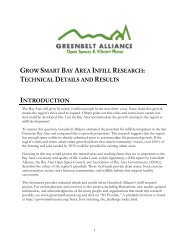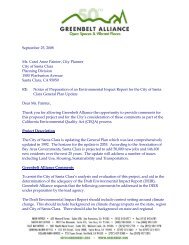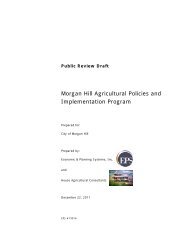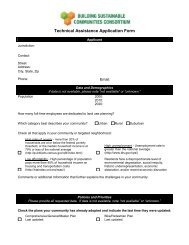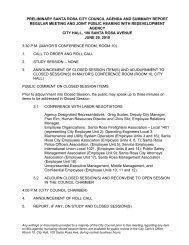You also want an ePaper? Increase the reach of your titles
YUMPU automatically turns print PDFs into web optimized ePapers that Google loves.
Photo: Steven Price, www.urban-advantage.com<br />
Before and after: a street with infill development around transit. This<br />
computer-generated image shows how good development can create more vibrant<br />
neighborhoods while directing growth away from the greenbelt.<br />
Encouraging Better Growth<br />
in Cities<br />
City general plans should encourage<br />
good urban infill by mixing land uses,<br />
increasing heights and densities<br />
where appropriate, and focusing<br />
compact development around transit<br />
stations. Including affordable<br />
housing in cities is also critical to<br />
keeping development pressure off the<br />
greenbelt. Tools for good growth in<br />
cities include mixed-use zoning, to<br />
put homes, shops and jobs in close<br />
proximity; streets and buildings<br />
designed for pedestrians; reduced<br />
parking requirements; and affordable<br />
housing policies.<br />
Investing in Better<br />
Transportation<br />
Voter-approved sales tax increases to<br />
fund transportation have the potential<br />
to fuel sprawl or to guide better<br />
growth. They fuel sprawl if they<br />
focus on creating and expanding<br />
highways. This fuels sprawl development<br />
in remote areas, and does not<br />
lessen traffic congestion for more<br />
than a few years. To protect the<br />
greenbelt and provide lasting solutions<br />
to traffic congestion, transportation<br />
funding should be tied to land<br />
use in two ways. The first is to<br />
require cities to have urban growth<br />
boundaries before receiving transportation<br />
funds, to prevent sprawl. The<br />
second is to require cities to plan for<br />
plenty of housing around train<br />
stations and bus lines, so that transit<br />
is convenient for many people.<br />
Transportation investments should<br />
also focus on supporting public<br />
transit, bicycles, and pedestrians<br />
rather than sprawl-inducing highways.<br />
This makes already-urbanized<br />
areas more attractive and affordable,<br />
reduces auto use and traffic congestion,<br />
and protects the greenbelt.<br />
Combining Tools for<br />
Effective <strong>Greenbelt</strong><br />
Protection<br />
A key lesson to be drawn from the<br />
Bay Area’s experience is that both<br />
smart land-use policy and land<br />
acquisition are necessary strategies;<br />
neither alone will save the greenbelt<br />
and create livable communities. The<br />
purchase of lands and easements is<br />
essential to the long-term security of<br />
the greenbelt, but better land-use<br />
policies can put many more acres<br />
beyond the reach of sprawl more<br />
quickly. <strong>At</strong> the same time, policies<br />
require vigilance on the part of the<br />
region’s voters, both in their enactment<br />
and enforcement. Progress in<br />
protecting the Bay Area’s greenbelt<br />
has been best where very strong<br />
general plan policies are backed up<br />
by complementary city and county<br />
policies, sound transportation<br />
investment plans, and strong landacquisition<br />
strategies.<br />
Growing Well Within<br />
the Boundaries<br />
A key question facing the region is<br />
how to use undeveloped lands within<br />
urban growth boundaries (UGBs).<br />
These lands, which are designated for<br />
development, must be managed<br />
carefully to keep them from disappearing<br />
quickly under an avalanche<br />
of sprawl, leaving nothing for the<br />
future.<br />
Drawing a UGB is just the first part<br />
of land protection. Growing well<br />
inside the UGB is the critical second<br />
half of the equation. For this reason,<br />
lands inside UGBs are still at risk;<br />
though they are the appropriate place<br />
for good development, they are still<br />
threatened by sprawl.<br />
Sprawl inside a UGB has all the same<br />
negative effects as sprawl elsewhere:<br />
it segregates homes, jobs, and shops;<br />
requires more car trips; increases<br />
traffic congestion and auto-related<br />
pollution; and makes neighborhoods<br />
less livable. On the other hand,<br />
mixed-use developments with good<br />
design, strong transit, and a range of<br />
housing types can strengthen an<br />
entire city in the near term and be<br />
sustainable or re-usable over the long<br />
term.<br />
14 <strong>At</strong> <strong>Risk</strong>: The Bay Area <strong>Greenbelt</strong>




